By now, many homeowners are aware that polyurethane injection is an economical and highly effective repair method for basement leak and foundation crack sealing; instead of digging up your home. On this page we cover what matters most to homeowners.
On this page:
The usefulness of polyurethane injection for foundation crack sealing
How polyurethane injection works
Video of a high pressure polyurethane crack injection
Types of leaks fixed by injecting polyurethane
Images of typical problems fixed by polyurethane injection
The attributes of polyurethane (PU) resin
The usefulness of polyurethane injection for foundation crack sealing
This type of foundation crack injection (sometimes referred to as urethane injection) is arguably the most common type of injection used for repairing basement leaks and waterstopping generally, due to its versatility. It is used exclusively for stopping leaks in poured concrete foundation walls, ceiling slabs and other structures. When waterstopping is required in subway tunnels and mineshafts, the cracks and rock fissures are injected under high pressure with polyurethane (also referred to as grout) – so you know this crack repair method works under real-life conditions.
It should be noted that in some instances epoxy crack injection is the preferred choice to repair foundation cracks; particularly foundation settlement cracks.
How polyurethane injection works
Polyurethane injection involves the pressurized injection of activated polyurethane resin through injection packers hammered into drilled holes into poured concrete basement foundation walls. This injected resin travels through the entire thickness of the foundation wall (typically 8″). Within the crack the polyurethane expands and solidifies within the cavity thereby eliminating the cavity and preventing water from leaking into your basement.
Note: Polyurethane can also be injected at a lower pressure using a process virtually identical to that used for epoxy crack injections.
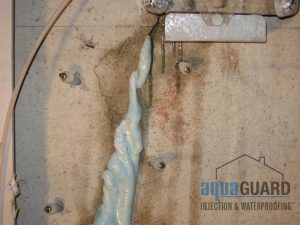
Injected polyurethane oozing out of an injected foundation crack
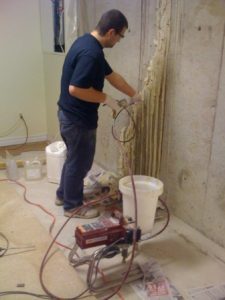
Polyurethane crack injection in progress
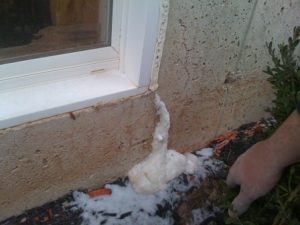
Expanded polyurethane which has travelled through the foundation to the exterior making excavation unnecessary
Video of a high pressure polyurethane crack injection
Types of leaks fixed by the injection of polyurethane
- Actively leaking cracks in poured concrete foundations;
- Foundation crack sealing of wet or damp basement walls;
- Previously repaired cracks (internally and/or externally) that are leaking. Note: an epoxy injection is not appropriate for repairing a failed crack injection;
- Cracks full of mud or mineral deposits;
- Cracks caused by corroding reinforcing bars (typically in reinforced concrete slabs in underground parking garages);
- Leaking forming tie-rod holes;
- Leaking forming snap rods;
- Leaking underground structures in general (such as parking garage cracks and seams);
- Underground pipe penetrations in a wall for electrical conduits, gas lines, air conditioning lines and pipes;
- Honeycombing;
- The bottom of swimming pools (when the underside is accessible);
- Seams created by a cold pour; and
- Overhead concrete structures.
Wondering how much a crack injection costs? Find out now!
Images of typical problems fixed by polyurethane injection
If any of the images below match your situation, polyurethane injection is a viable and cost-effective solution for you.
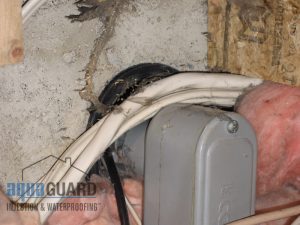
The conduit containing the electrical wiring bringing power to the electrical panel
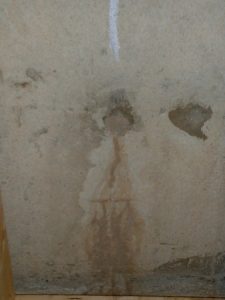
Leaking tie-rod hole – poured concrete foundation
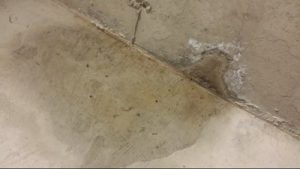
Visible water and staining coming from a leaking crack in a poured concrete foundation
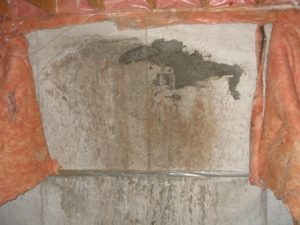
Leaking honeycombing (visible aggregate) in a poured concrete foundation caused by insufficient mixing of the concrete prior to pouring
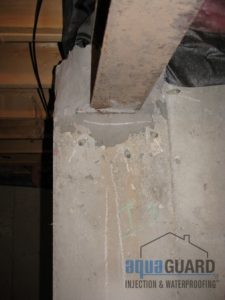
Leaking I-beam pocket – poured concrete foundation
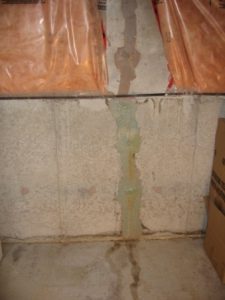
Leaking previously repaired foundation crack
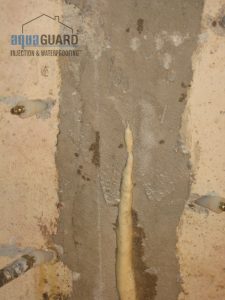
Sealing of a foundation crack that was patched over by a homeowner
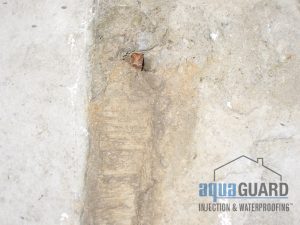
Leaking snap-rod – poured concrete foundation
The attributes of polyurethane (PU) resin
From reviewing the typical applications above, it is clear that polyurethane injection is an extremely versatile waterproofing method that can be used to deal with any basement leak in a poured concrete structure, under all conditions. This versatility is attributable to the characteristics of our polyurethane resins which are:
- Our activated polyurethane typically expands to 2.5 times it’s volume; this is very desirable when filling large cavities or when the size of a cavity is unknown (as in the case of honeycombing);
- The expansive force of polyurethane is significant; consequently, it will fill any and all gaps that it encounters – this is particularly useful when foundation crack sealing of very porous concrete or when dealing with honeycombing. It will also expand wherever it can; following the path of least resistance, it will fill any and all voids encountered;
- Some polyurethane resins are non-toxic; this makes them suitable for use with potable water systems such as cisterns;
- Polyurethane sets rapidly in the presence of hydrogen. Since hydrogen molecules are a component of water (H2O), the presence of water during an injection actually increases the reactivity of the polyurethane. This makes polyurethane the ideal product to use when active basement leaks and/or significant hydrostatic pressure, are encountered;
- The polyurethane resins that we use will not freeze and always remain flexible (not an attribute of all polyurethanes). This is desirable when the concrete surrounding it expands and contracts due to thermal cycling;
- Polyurethane sets very quickly – this is essential in stopping leaks where significant hydrostatic pressure is present;
- High pressure polyurethane injections employ hydraulic hoses which are crucial when accessibility to the repair area is limited; and
- At AquaGuard Injection & Waterproofing® we adjust the viscosity of our polyurethane resin; this gives us the ability to deal with any underground leak situation, from hairline cracks to large voids.
Note 1: Several technical factors need to be taken into account to determine whether a basement leak should be injected using epoxy or polyurethane. For example, the effects of tension and compression at the crack location must be factored into the decision on how best to deal with your leak repair. Their is alot of science behind injection repairs; trust our trained technicians to determine whether polyurethane injection is optimal for your circumstances.
Note 2: Not all Waterproofing Contractors offer high pressure polyurethane injection basement leak waterproofing repairs. Why? Because it takes training, skill, knowledge, high quality polyurethane formulations, professional injection equipment and determination to perform a successful polyurethane injection; otherwise the injection will likely fail. As significant training and a commitment to work excellence is crucial, many companies shy away from polyurethane injections because they cannot reliably produce successful results. The demanding nature of polyurethane injection is so significant that some of our competitors call upon us to perform their warranty repairs!
Want more information on how foundation cracks are injected? Call us today!

